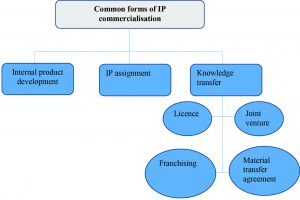Intangible form of property 
Intellectual property is an intangible form of property. It is a creation of human intellect which forms an integral part of our life. Starting from an alarm clock that annoys us in the morning to an interesting novel that makes us dream at night, we are surrounded by the fruits of human creativity and innovations. It serves to protect creative and inventive human expressions. Intellectual property rights, being imperative tools for the economic and industrial development of the nation, the laws protecting them have assumed great importance in the era of globalisation and privatisation.
IP: Source of value and wealth generation
The term “intellectual property” which was hardly known to the CEOs in early ‘90s has become one of the most significant parts of their business strategy.[1] Intellectual property has great significance for any large scale, medium scale or even a small startup as it has become an important source of revenue generation. In this age of knowledge and technology, generation of revenue is through creation of intellectual wealth. The intellectual wealth so generated requires strategic and structured approach towards identification, protection and exploitation for revenue generation. The source of value and wealth generation has moved from tangible to intangible assets. Intangible assets as recognised to be intellectual property are nothing less than potent weapons in the age of global competition. Intellectual property rights are not mere legal instruments but are tools of business. Thus, the area of management of intellectual property rights (IPRs) has great significance in the present world of explosive technological developments. With the rapid growth in diversified fields of technology, with the new scientific inventions and innovations, IPR protection and IPR exploitation is the key to commercialisation for any organisation. There is no doubt that the success in the smart phone industry is completely based on innovations. Some of the leading examples of success stories like software—Microsoft, hardware—Dell, and formulations—Coca-Cola are substantiating the fact that managing intangible asset can take any organisation on the path of success.
What is IP management
Management of IP includes the entire process of identifying, acquiring and protecting intellectual property of the organisation for the purpose of value and wealth generation.
Need for strategic management of IP
Strategic management of intellectual property for any organisation fosters creativity and innovation leading to generation of IP with potential for value extraction. It facilitates licensing and technology transfer of IP as well. It further leads to enhancing in-house competencies in understanding, identifying, generating, protecting, sharing and transferring IP. Strategic management of IP also helps prevent any unethical acts to avoid IP infringement at all levels and develop guidelines and facilitates IP sharing in joint development and collaborative projects with third parties. It helps the organisation maintain competitive edge.
Strategies to manage IP
Strategic management of intellectual property is needed at all stages starting from concept to commercialisation. Managing an IP portfolio is not merely acquiring a formal recognition of type of intellectual property right through a certificate of registration issued by the national IP office. IP management encompasses all IP rights including patents, designs, trade marks, copyrights, semiconductor integrated circuits layout designs, software programs, industrial designs, logos, confidential information, drawings, source codes, technical information, and any other knowledge/know-how created by the employees and affiliates of the organisation.[2] Strategic IP management impacts opportunity exploitation and the utilisation of existing resources. In order to support opportunity exploitation activities, IP management must ensure freedom to operate within a certain domain, for example a patent does not provide the patent-holder freedom to operate; exclusive rights related to necessary complementary resources can be held by other agents restricting and blocking the freedom to operate, possibly leading to hold-up problems and tragedies of the anticommons.[3] Further it can also be said that strategic IP management impacts opportunity exploration and dynamic capabilities. An example is the use of Frand requirements in some standards, meaning that participants must agree to licence out their essential patents to fair, reasonable, and non-discriminatory (Frand) licensing terms. A “tight” appropriability regime is then not necessarily most conducive for dynamic competitiveness, especially not if widening the scope from the firm perspective to the perspective of innovation networks and technological ecosystems. Strategic IP management can thus be used to proactively ensure accessibility to innovations, in order to promote cumulative innovation under certain conditions.[4]
Identifying IP.— Under the wide-ranging head of intellectual property rights, various forms of innovations are protected as patents, trade marks, copyrights, industrial designs, trade secrets and many more. The identification of IP is not a simple exercise. Hence, it is important for an organisation to carefully consider the importance of IP to its operations before embarking on what may be a fruitless and costly journey. Therefore following issues have to be addressed while identifying an IP that a company owns are as follows:
(i) Selecting a company name, domain name and trademark.
(ii) Identifying your products or services.
(iii) Determining which of your products and services can be protected as IP.
(iv) Distinguishing what type of IP protection applies to each of your products and services.[5]
Acquiring.— Considering the potential of value and wealth generation, IP assets should also be considered from a long-term point of view. Hence acquiring IP includes managing the chain of title to company-developed IP.
Monitoring.— It has to be done of the internal and external use of IP. All types of IP portfolio has to be systematically monitored. Once IP rights are acquired, one must take more steps to enforce those IP rights; if you do not, then there is no consequence to a potential infringer.
Commercialising.—When it comes to transfer technology from research organisations (ROs) to the business sector or to manage the intangible assets in small and medium-sized enterprises (SMEs), the intellectual property (IP) commercialisation practice is a key factor. Commercialisation is therefore the process of bringing the IP to the market in order for it to be exploited in return of business profits and growth. The financial success of any IP commercialisation will certainly depend on the choice of the most appropriate commercial tool.
IP commercialisation: The Unidyne case[6]
Unidyne Energy Environment Systems, a company engaged in manufacturing various insdustrial thermal energy systems. In 1999, Unidyne signed a memorandum of understanding (MoU) with Indian Inventor, Dr Milind Rane, who developed the design of matrix heat recovery unit (MHRU). This invention was used for recovering heat from hot gases and/or vapors from engines, boilers or furnaces. Unidyne saw value in the patent application, which was still not granted the status of a patent by the patents office. Dr Rane, through the MoU licensed his technology to Unidyne to manufacture and sell MHRUs. The patent was granted in 2004 and is now being used by more than 45 companies in India. For Unidyne, the agreement act as a tool to boost its product.

Figure 1: Common forms of IP commercialisation[7]
Intellectual property is outcome of knowledge and creativity. It is foundation for evolution and progress in each and every sphere of human accomplishments. Moreover in the age of information technology, intellectual property rights and intangible assets are gaining significant importance. Businesses cannot ignore the developments in the intellectual property regime. Intellectual property rights and intangible assets represent a major portion of the assets of a business, thereby constituting a large share of its value. Managers must be equipped with the necessary understanding of the tools and techniques that help them to protect innovations of the business, the creative works surrounding these innovations, the look, feel and design of the products as well as brands which generate value to the business. The national IPR policy also emphasises the need for a strategic perspective in managing intellectual property and has put in place a lot of measures to facilitate the “mind to market” among the MSMEs and other industries. There is an evident urgency in implementing an effective IPR policy within organisations in order to achieve its overall strategic intent.
| *Vaishali Singh is Research Associate, GNLU-Microsoft IPR Chair, Gujarat National Law University. |
[1] Jain, Karuna, Intellectual Property Management System: An Organisational Perspective, Journal of Intellectual Property Rights (2006), pp. 330-333.
[2] See William W. Fisher III & Felix Oberholzer-Gee, Strategic Management of Intellectual Property: An Integrated Approach, California Management Review (2013) 55 CMR.BERKELEY.EDU, available at <http://www.hbs.edu/faculty/Publication%20Files/CMR5504_10_Fisher_III_7bbf941f-fe1b-4069-a609-9c6cd9a8783b.pdf> (last accessed on 21-11-2017).
[3] See Holgersson Marcus, Innovation and Intellectual Property: Strategic IP Management and Economics of Technology, available at: <http://ssrn.com/abstract=2563297> (last accessed on 1-12-2017).
[4] Ibid.
[5] See MaRS Entrepreneur Workbooks, Identifying your intellectual property, available at: <https://www.marsdd.com/wp-content/uploads/2010/12/Identifying-Your-Intellectual-Property-WorkbookGuide.pdf> (last accessed on 1-12-2017).
[6] Bandyopadhyay, T.K., “Introduction on Intellectual Property to Engineers and Technologists”, available at: <http://textofvideo.nptel.ac.in/109105112/lec40.pdf>. See also <http://www.unidyne-energy.com/> (last accessed on 23-11-2017).
[7] See <http://ship.mrc.ac.za/invention.htm>.








Such a short and helpful post to guide on intellectual property. Thank you for sharing the very helpful post.